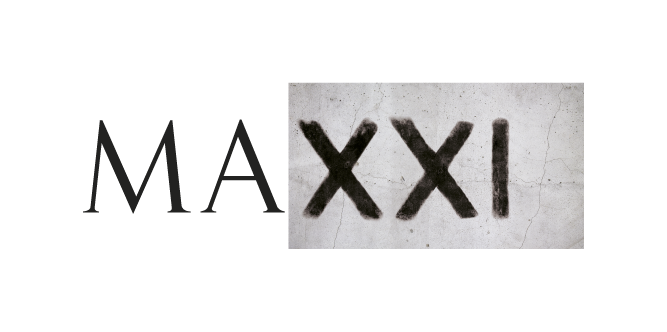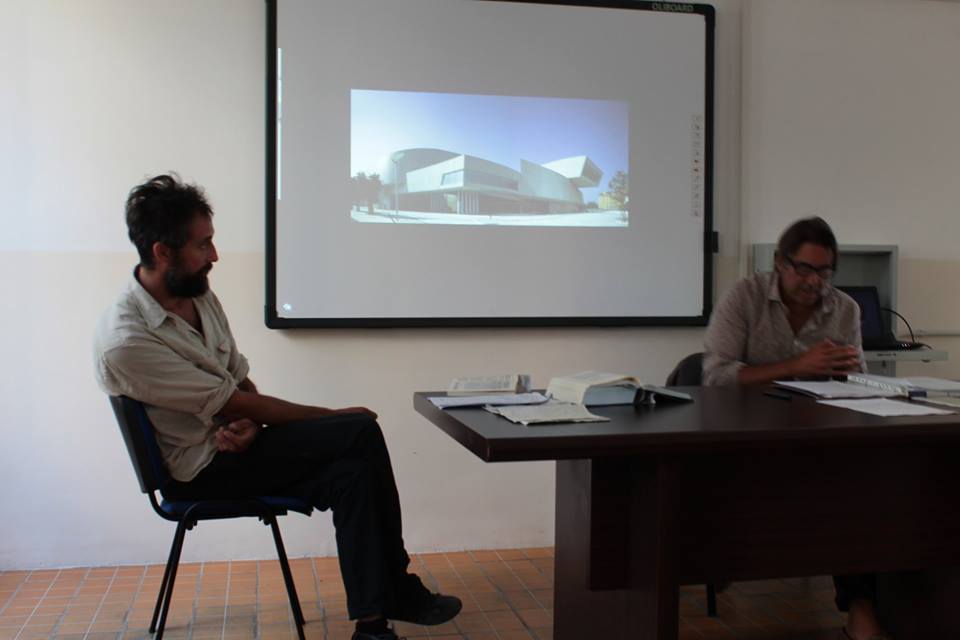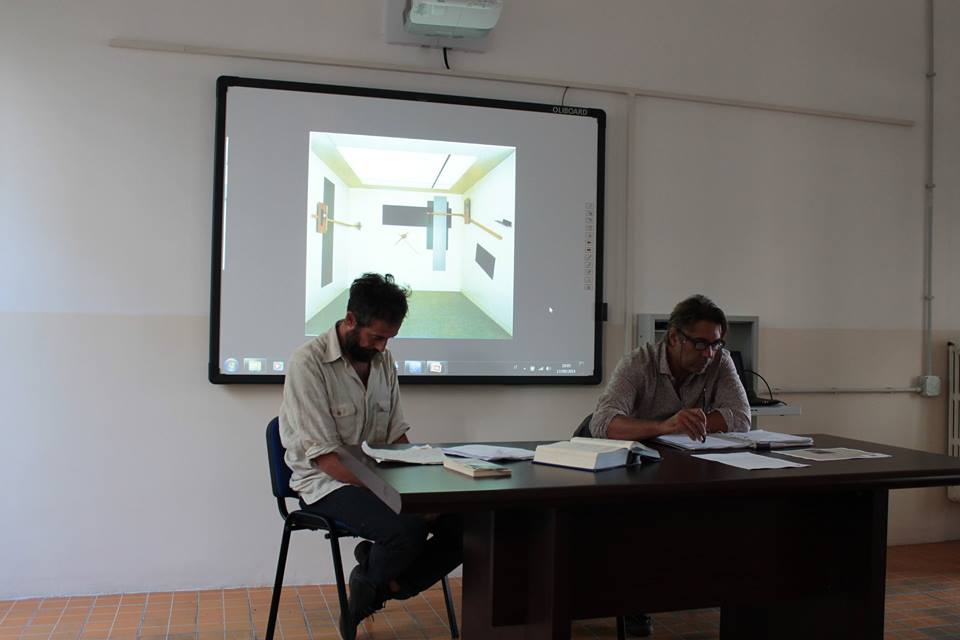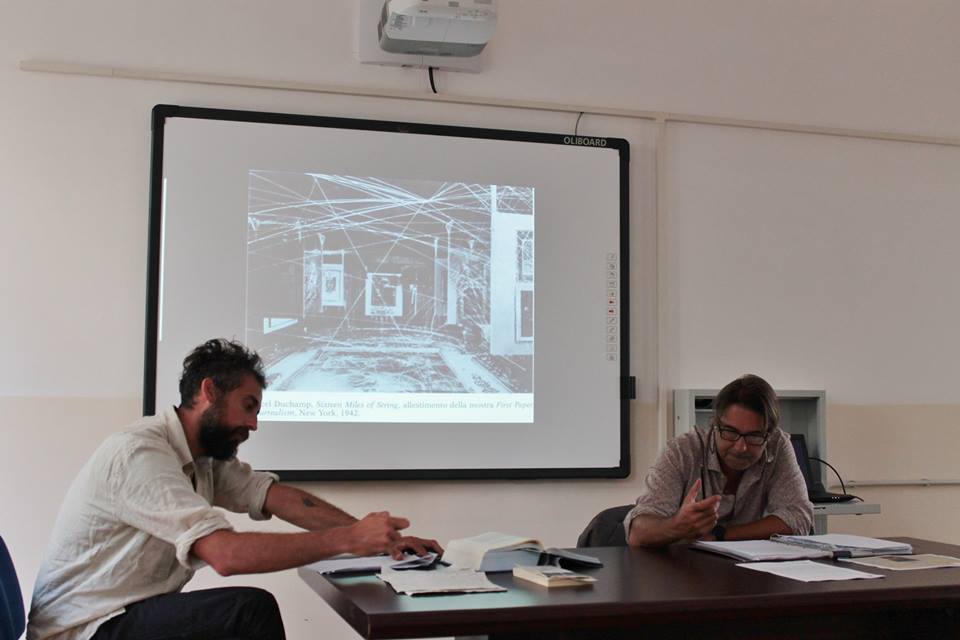MUSEO SUONO OPERA – UN PROGETTO A TRE DIMENSIONI
OPEN MUSEUM OPEN CITY
ITA
Il suono diventa la chiave d’interpretazione della realtà, un modo speciale per esplorarla, per creare un museo aperto, esempio condensato di una città aperta.
Il progetto offre l’interessante possibilità di ripensare il rapporto tra la produzione artistica, gli interventi architettonici e la partecipazione del pubblico. Una riflessione sulla complessità di Roma, foro moderno della trasformazione urbana e degli esperimenti socio-culturali.
La mostra si terrà nel MAXXI, il Museo nazionale delle Arti del XXI secolo, che verrà “svuotato” e riempito di suoni. Dal suono fluido dell’acqua che scorre sotto la città di Roma, alla scomposizione di un pezzo musicale in singole note, dai rumori della città al ritmo della rivoluzione e molto altro ancora.
Le opere sonore e le azioni tra artisti e pubblico, trasformano, in modo immateriale ma comunque spettacolare, le gallerie del museo in spazi urbani, intimi, virtuali, digitali, spirituali e politici. Questi elementi ridefiniscono la natura degli spazi del MAXXI e del suo significato pubblico.
Il progetto si articolerà in ambienti interattivi generando una molteplice e complessa esperienza: “uno spazio di due sistemi”.
Il suono diventa il pretesto per collegare creatività e tecnologia.
Il pubblico avrà modo di produrre “mondi interni” del tutto personali e originali grazie al progetto di zonizzazione che definisce un nuovo modello di urbanizzazione. La funzione del museo verrà , dunque, ampliata a piazze, strade, edifici, case, mercati, ristoranti, caffè, teatri, giardini, boschi, laghi, monumenti, labirinti, asili, scuole, ospedali , bordelli, stazioni di polizia, stadi, case, camere e monolocali.
Le opere saranno il frutto del rapporto tra staticità e movimento, materia e suono, artista e spettatore.
ENG
An exhibition that comes to life in the whole museum, an extra-ordinary opportunity to analyze some of the most important issues of our times, through sound. The project offers an interesting opportunity to rethink the relationship between the production of art, architectural interventions and public participation. It could be considered a reflection on the complexity of Rome, center of modern urban transformation and socio-cultural experiments. Sound becomes the key for the interpretation of reality, a special way to explore; to create an open museum, a condensed example of an open city.
The MAXXI is transformed into an open forum, a unique platform for dialogue and for the proposal of new social projects “emptying the space” and filling it with sounds. From the sound of water flowing fluid under the city of Rome, the decomposition of individual notes in a piece of music, the noise of the city to the rhythm of the revolution, and much more.
The exhibition will transform the museum into a stage, between different voices and demands of new social works of art by using radical techniques. “Emptying the building” and filling it with sound. The sound identifies several issues in the process of zoning, it defines the pattern of urbanization. The museum will be occupied by sound installations which will seem immaterial, but still spectacular, the sound installations and actions of artists and audience will create tunnels in urban spaces, intimate, virtual, digital, spiritual and political. These elements will redefine the nature of the museum and its public meaning. The project will consist of interactive environments, between stillness and movement, material and immaterial, the artist and the audience. Installing static and personal audio systems, mobiles(with works which have contributed to the artist and the audience …) will generate a complex experience: “a space of two systems.” The sound is an excuse to connect creativity and technology.
Navigation through urban and mental spaces will cause an expansion of the function of the museum, it can become a part of the urban structure. The plants live together with a static architectural reality and mobile personal systems produce “inner worlds”.
The works of art and museum will be designed and installed according to the logic of zoning: squares, streets, buildings, houses, public buildings, markets, restaurants, cafes, theaters, gardens, woods, lakes, monuments, walls, mazes, kindergartens, schools, hospitals, brothels, police stations, stadiums, houses, rooms and studios.
The works will be the result of the relationship between stillness and motion, matter and sound, artist and viewer.
LORENZO GOMIERO, Analogico e Digitale
Sonoro: 2′ 1″, 2014
LORENZO GOMIERO e SIMONE MARZIALI si sono occupati del progetto musicale all’interno del percorso didattico del MUSUO. Lorenzo Gomiero ha alternato suoni analogici e digitali in una registrazione sonora del 12 Novembre 2014
VISITA ALLA MOSTRA “OPEN MUSEUM OPEN CITY”
Il 28 ottobre dopo essersi recati al MAXXI, sotto la guida di Antonella Muzi e Claudia Fiasca, gli studenti dell’ABAV hanno avuto modo di esaminare le opere esposte.
Ryoji Ikeda esamina la nota “La” ,in quanto è all’origine della musica, in “A [4ch version]” . la sala si riempie di suoni che si sovrappongono nel nostro orecchio creando un effetto simile al battimento grazie a quattro casse che emettono la nota con frequenze differenti.
Haroon Mirza propone il tema della compenetrazione tra esterno e interno, tra museo e città in “External Binaural Envelope”. La quotidianità viene portata nella sala grazie a dei microfoni che registrano in tempo reale sia suoni delle auto e delle genti che passano per via Guido Reni, che quelle dei fruitori nel museo.
Lara Favaretto ripropone “Doing” del 1998 in “Window” l’opera di Anish Kapoor . Dei suoni martellanti fanno intendere all’ascoltatore che si stanno verificando dei lavori in corso, al contrario la registrazione riguarda degli operai che stanno disintegrando dei blocchi di marmo fino a renderli solamente polvere.
Justin Bennet ci propone due opere, “Hyper – Forum” in cui ci fa immergere, tramite una sfera sonora immaginaria, nel bel mezzo di una piazza , e “Oracle 2.0” che come dice il titolo stesso è un vero e proprio Oracolo che si attiva casualmente e non a tutti i visitatori.
Philippe Rahm trascina l’osservatore in un mondo tutto nuovo, quasi utopico con “Sublimated Music”. Qui di notevole importanza è anche il senso della vista, infatti, il gioco di luci influisce notevolmente alla sublimazione del suono. Le note che vengono emesse dagli spikers vanno a comporre un pezzo di “Cloches à Travers les Feuilles” di Debussy che si completa a mano a mano che lo spettatore avanza.
Francesco Fonassi rielabora il concetto di relazioni umane in “Territoriale”, un’opera composta da due spazi divisi da una parete. Grazie a dei microfoni che elaborano i suoni dei passanti in note bianche, ogni parte della stanza produce suoni più o meno forti in base alla quantità di gente che passa dall’altra parte della parete, proprio come l’animo umano subisce variazioni quando si avvicina ad altre persone.
Jean-Baptiste Ganne rielabora le gesta di Don Chisciotte in un opera silenziosa interamente realizzata in codice morse con “Il guerriero solitario”. L’opera, visibile anche dall’esterno, viene letta e presentata tramite una luce rossa che percorre un intero corridoio.
Cevdet Erek invita all’unione e alla ribellione con “l’insurrezione che verrà – The Uprising to Come”. Cerca di mobilitare le masse, farle uscire di casa e ritrovarsi in piazza per creare una vera e propria rivoluzione.
“Narrazioni” è un ciclo che consiste in quattro performance di Chiara Fumai, Marinella Senatore, Valentina Vetturi e Elisa Strinna. Quest’ultima in particolare analizza il tema delle cartografie latenti. Studia il rapporto tra idea di società e la vita reale delle persone.
Bill Fontana, infine, ci accompagna durante tutto il percorso con “Soning Mappings”. Il suono degli acquedotti di Roma viene decontestualizzato e inserito all’interno del Museo quasi come se fosse un proseguimento del percorso. Inoltre gli spikers sono stati disposti su tutto il tragitto delle scale, infatti, quest’ultime ricordano l’andamento fluido dell’acqua.
Quest’esperienza è stata senz’altro molto coinvolgente ed è stato un ottimo punto di partenza per il progetto MuSuO.
ENG
On October 28, we went to the MAXXI, under the guidance of Claudia Fiasca and Antonella Muzi, us students of the ABAV got to take look at the exhibition.
Ryoji Ikeda examines the note “A”, as it is the origin of music, “A [4ch version].” the room, filled with sounds that overlap in our ear, creates an effect similar to a beat thanks to four speakers that emit the note in different frequencies.
Haroon Mirza proposes the theme of interpenetration between inside and outside, between the museum and the city “External Binaural Envelope”. Everyday life is brought into the room through microphones that record in real time the sounds of cars and people passing by via Guido Reni, and those of the workers inside a courtyard within the museum.
Lara Favaretto proposes “Doing”, a work from 1998, within “Window” the installation of Anish Kapoor. This artwork lets the listener hear the banging sounds that occur while work is going on, instead the recording is made of workers who are disintegrating block of marble, until it becomes just dust.
Justin Bennett is proposing two works, “Hyper – Forum” in which he plunges us, through an imaginary sphere of sound, in the middle of a busy square, and “Oracle 2.0” which as the title itself is a veritable oracle that randomly activates, however not to all visitors.
Philippe Rahm draws the viewer into a whole new world, with the almost utopian “Sublimated Music.” Here, the sense of sight is very important, in fact, there is a play of lights that greatly affects the direction of the sound. Single notes are issued by speakers, which as you walk begins to compose a part of “Cloches à Travers les Feuilles” by Debussy, which finally is completed in as the viewer moves.
Francis Fonassi reworks the concept of human relations in “Territoriale”, a piece composed of two spaces separated by a wall. Thanks to the microphones that process the sounds of passing people into the white notes, each side of the room produces sounds that vary in strength depending on the amount of people passing by on the other side of the wall, just like the human soul undergoes changes as it approaches other people.
Jean-Baptiste Ganne reworks the exploits of Don Quixote in a work made in silence, doing this in Morse code, “The lone warrior.” The work, which is visible from the outside, is read and presented through a red light along an entire corridor.
Cevdet Erek calls to unity and rebellion with “The Uprising to Come.” He tries to mobilize the masses, to get them out of the apartment buildings onto the streets to create a revolution.
“Narratives” is a cycle that consists of four performances of Chiara Fumai, Marinella Senatore, Valentina Vetturi and Elisa Strinna. The latter, in particular, explores the theme of concealed maps. She studies the relationship between society and the real lives of people.
Bill Fontana, follows us within the whole museum with “Sonic Mappings”. The sound of the aqueducts of Rome is out of context and placed inside the museum, almost as if it were a continuation of the waters path. In addition, the speakers were placed on all of the stairs, in fact, the stairs give us the feeling reminiscent of the fluent water.
This experience was certainly very engaging and it was a good starting point for the project MuSuO.
SOUND PORTRAIT
Il giorno 22 Ottobre presso l’Accademia di Belle Arti Lorenzo da Viterbo ABAV, abbiamo sperimentato l’intersecazione tra immagine e suono, chiedendo a ciascuno dei partecipanti (studenti ABAV) di scegliere un suono o rumore che lo rappresentasse. Il risultato lo potete vedere qui sotto
SECONDO INCONTRO AL MAXXI
Durante il secondo incontro, svoltosi il 15 ottobre al MAXXI, la storica dell’arte Claudia Fiasca ha esposto il percorso storico-musicale in relazione all’arte. Già nel ‘500 Leonardo Da Vinci aveva enunciato la differenza tra musica e arte, definendo la prima come un qualcosa di effimero e la seconda come duratura nel tempo. Una prima riflessione sul silenzio è invece riconducibile a Jean-Baptiste Siméon Chardin grazie alle sue numerose nature morte. Con gli Impressionisti si riescono a cogliere quelle atmosfere e suggestioni che solo la musica è in grado di creare. Anche con Braque e Picasso si possono trovare dei riferimenti alla musica, con particolare attenzione alle chitarre, ma la prima e vera applicazione della musica nell’arte avviene con Kandinski, come è evidente nel suo manuale”Il Suono Giallo” dove paragona ogni colore ad uno strumento particolare. A trarre ispirazione dal Jazz è Mondrian che cerca di unire ritmo, proporzione ed equilibrio, grazie ad un processo di purificazione che coinvolge colore e suono. Nei dipinti futuristi sono evidenti forti richiami al suono inteso come frutto delle nuove tecnologie, ed è qui che entra in gioco il rumore inteso come elemento del quotidiano in grado di richiamare la vita stessa. In merito a ciò Russolo crea l’Intonarumori. I pittori dadaisti adoperano il teatro come palcoscenico per delle performance chiassose e disorientanti con lo scopo principale di scatenare le reazioni del pubblico. Ne sono esempio Ball, Arp, Satie e Man Ray che con il suo “Autoritratto” porta a una riflessione sul silenzio anticipando John Cage. Quest’ultimo riesce a togliere l’autorità sia alla figura dell’autore che a quella del performer mettendo in scena un pezzo teatrale multimediale passato alla storia come “Black Mountain Piece” dove la casualità, già anticipata da Duchamp, regna padrona. Gli insegnamenti di Cage e Satie vengono ripresi dal Fluxus, un movimento che aveva lo scopo di recuperare l’esistenza del suono al di fuori della musica.
La Sound Art è il movimento artistico-musicale per eccellenza che si propone di ascoltare i suoni provenienti dalla natura esterna. Come spiega Daniela Cascella esistono tre principali generazioni di questi artisti.
-Una prima può essere ricollegata a Christina Kubisch che nella sua opera “Electrical Walks” ci aiuta a cambiare la percezione del reale creando delle mappature di campi elettromagnetici che, grazie a speciali cuffie, vengono trasformati in suono.
-Notevole è anche la duplicità di Carsten Nicolai che in “Project for Doumenta X ” mappa tutta la città registrando più di 47 suoni e collocandoli in posti che le decontestualizzano.
-John Duncan denuncia le violenze sessuali contro i minori in “The Keening Towers” un opera dove delle casse acustiche vengono inserite sopra ad un palazzo e trasmetto cori di bambini modificati fino a diventare lamenti.
Fra le mostre più recenti si possono analizzare “Sounding: a Contemporary Score” del Moma dove hanno esposto artisti come Stephen Vitiello,Michele Spanghero, Donatella Landi, Roberto Pugliese Jacob Kirkeegaard, Christine Sun Kim, Bill Fontan, Micol Assaël e tanti altri ancora. In questo percorso è evidente come il termine “Arte” non debba essere ricollegato solo al senso della vista, bensì a tutti e cinque i sensi.
ENG
During the second meeting, held on October 15 at the MAXXI, the art historian Claudia Fiasca exposed the historical-musical development in art.
Already in the ‘500 Leonardo Da Vinci had shown the difference between music and art, defining the former as something ephemeral and the second as durable. Instead, the first portrayal of silence can be seen in the works by Jean-Baptiste Siméon Chardin, he shows it in the numerous still lifes which portrayed musical instruments.
With the Impressionists you are able to grasp the atmosphere and charm that only music can create.
Even within works of Braque and Picasso there can be found references to the music, with an emphasis on guitars, but the first real application of music in art is with Kandinsky, as is evident in his textbook “The Yellow Sound” where he compares each color to a particular musical instrument.
Mondrian, inspired by Jazz music, combined rhythm, proportion and balance within his works, thanks to a purification process that involves color and sound.
In Futurist paintings there are obvious references to the sounds resulted by new technologies, and that is where the noise comes into play. It is considered as an element of daily life that can recall life itself. In this respect Russolo creates the Intonarumori.
The painters of the Dadaist movement used theater as a stage for the portrayal of noisy and disorientating sounds for the main purpose of triggering reactions within the audience. Examples include Ball, Arp, Satie and Man Ray; with his “Self-Portrait” which leads to a reflection on silence, anticipating John Cage. The latter is able to remove the authority of both the figure of the author and that of a performer, staging a multimedia theatrical performance in “Black Mountain Piece” where randomness, as already anticipated by Duchamp, is the reigning mistress.
The teachings of Cage and Satie are taken from Fluxus, a movement that aimed to recover the existence of sound outside of music.
Sound Art is the artistic movement that aims to listen to the sounds coming from the external nature. As explained by Daniela Cascella there are three main generations of these artists.
-A First can be traced to Christina Kubisch that in her work “Electrical Walks” she helps us to change the perception of reality by creating mappings of electromagnetic fields which, thanks to special headphones are transformed into sound.
-There Is also the duplicity of Carsten Nicolai in “Project for Doumenta X” where he maps the entire city and recorded more than 47 sounds, then putting them in places that decontextualize the sound itself.
-John Duncan denounces sexual violence against children in “The Keening Towers” an art work where large speakers are placed on top of a building and emit voices from a children’s choir which slowly are modified to become screams and eerie sounds.
Among the most recent exhibitions of Sound Art is “Sounding: a Contemporary Score” from the Moma, where artists such as Stephen Vitiello, Michael Spanghero, Donatella Landi, Roberto Pugliese Kirkeegaard Jacob, Christine Sun Kim, Bill Fontan, Micol Assa ël and many more exhibited their own works of sound Art.
In this journey it is clear that the term “art” should not be reconnected only to the sense of sight, but to all five senses.
ABAV AL MAXXI
Venerdì 10 Ottobre gli studenti ABAV si sono diretti presso il museo di arte contemporanee MAXXI di Roma. Ad accoglierli Antonella Muzi del Dipartimento educazione MAXXI, che ha illustrato agli studenti l’importanza di creare un museo d’arte del XXI Secolo nazionale. Passando dalla filosofia della costruzione architettonica della archistar Zaha Hadid, arrivando ad illustrare una vera e propria officina di giovani artisti che hanno la possibilità di esporre in un museo inserito in un contesto internazionale.
SECONDO INCONTRO
PRIMO INCONTRO
SISTEMI MUSEALI E LAVORARE SUL SUONO
Nella giornata di Mercoledì 16 Settembre, presso l’Accademia di Belle Arti Lorenzo da Viterbo, si è svolto il primo incontro inerente al progetto MUSUO; l’appuntamento moderato dal Professore Marcello Carriero, ha visto come ospite il musicista e compositore Andrea Araceli. Il Professor Carriero ha spiegato la relazione tra mostra artistica e museo e la relazione che intercorre tra museo e città. Successivamente il musicista e compositore Araceli ha descritto la sottile melodia tra musica e rumore.
OPEN MUSEUM OPEN CITY
L’accademia di Belle Arti Lorenzo da Viterbo ha stipulato una convenzione con il MAXXI, museo nazionale delle arti del XXI secolo, per un progetto che prevede la costruzione di un percorso didattico-formativo presso la sede del museo romano in via Guido Reni, nei mesi di ottobre e novembre 2014.
Alla base di questa collaborazione sussiste in primis la volontà di avvicinare gli allievi dell’Accademia al mondo dell’arte contemporanea introducendoli, dapprima, all’analisi dei sistemi museali e del modo in cui questi vengono strutturati per arrivare, poi, alla realizzazione di un prodotto finale che testimoni l’esperienza vissuta. Il progetto, in base al quale il MAXXI verrà svuotato e riempito di opere sonore, offre la stimolante possibilità di ripensare il rapporto tra produzione artistica, interventi architettonici e partecipazione del pubblico.
Il programma del nuovo direttore artistico Hou Hanru consiste proprio nel rimuovere tutte le opere “materiali” per aprirlo al dialogo. Da troppo tempo, infatti, le strutture museali sono concepite dal pubblico fruitore come delle chiese ed esso, rivestendole di una sacralità che non gli è propria, tende a costringersi nel mutismo. Al contrario è proprio di fronte alle opere d’arte che lo spettatore dovrebbe esporre le proprie impressioni ed opinioni, ascoltare quelle altrui per poi creare un vero e proprio dibattito. Perché al termine “arte” non si può non associare anche la voce “democrazia”. Il suono diventa, dunque, la chiave di lettura della realtà, grazie alla quale è possibile creare un museo aperto, uno spazio volto al dialogo tra voci diverse per rifondare l’idea di istituzione culturale.
Ogni settimana a partire dal 23 ottobre fino al 30 novembre le opere verranno sostituite di volta in volta da altre realizzazioni artistiche. Tale impegno, enorme anche dal punto di vista tecnico, costituisce un passo fondamentale per mostrare un prototipo della nostra società.
Il suono, che opera sia nel contesto museale che in riferimento alla città, permette al museo di aprirsi al sistema urbano, analizzandone sviluppi, cambiamenti e problematiche.
Gli allievi dell’Accademia che saranno protagonisti di questo processo produttivo e creativo, affiancati dal rettore Luigi Sepiacci,dal professor Marcello Carriero e dallo staff del dipartimento educazione del MAXXI, presenteranno, poi, il progetto presso l’Accademia di Belle Arti “Lorenzo Da Viterbo”. In quest’occasione gli studenti coinvolti si porranno come mediatori raccontando l’esperienza vissuta ai loro coetanei.
In tale occasione saranno coinvolti tutti i partecipanti, gli studenti dell’Accademia, la comunità territoriale di Viterbo che i ragazzi dovranno coinvolgere e richiamare, le famiglie degli studenti, i rappresentanti del MAXXI, i professori direttamente coinvolti e il corpo docente.


















